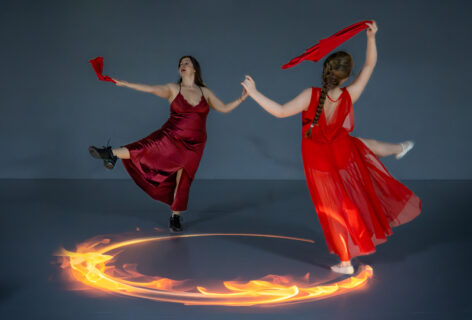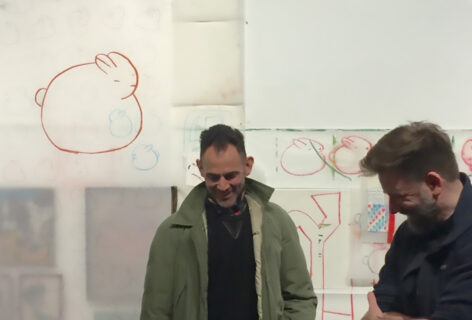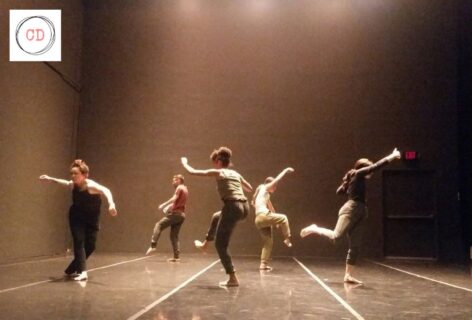Translated to English by Camila Vélez Álvarez and Nicole Soto Rodríguez
Cuauhtémoc Lara Razo: I got to that place because I was doing Lope de Vega’s play, where I was playing the protagonist. I arrived and while there, the teacher (this man called Ibañez) saw me and asked me, “why are you playing the lead role?” Don Alonso was the lead role; and then he tells me, why are you playing Don Alonso? And I replied, “well I don’t know, because the director said so”. Then he said, “Don Alonso is a hunk, you’re too fat to be Don Alonso”. And I didn’t know what to do, I felt humiliated, that hurt a lot and I ran out from that rehearsal. I left that rehearsal and went looking for another class to sign up for that week and the only one that had some space left was the performance workshop with Violeta Luna at la Pocha Nostra.
Just like that, performance came into my life and never left. I understood that performance was a place where my body was valuable just for just being and that what my body involves is a place of action. Since then it became a space for rebellion and from where to kick the balls of all conservatism in art and an escape from its structures of policing. That’s how I got to performance and began meeting visual artists, began meeting people working with performance and I began to perform. At the same time, more or less around those years, something very brutal happened in Mexico, the disappearance of 43 students from Ayotzinapa who were also from my generation. Something inside me collapsed, clearly I wasn’t the only one who felt it. And performance became the ally, we needed to make sense of the horror that was happening, and we decided to do it together. That meant that in the mornings we did performances in the streets together and in the afternoon we marched. We were a couple of people, we were also kind of crazy.
Now I’ve been thinking about the work of memory as an artistic practice, as a creative political practice. Thinking about what happens to memory? How and who articulates it? And what possibilities theatricality and performance have to build upon? I love to think about theater being the place to start because it is a transitory art and I think there is an interesting tension there, i have been thinking about this in my practice for quite a while, the relationships I have weaved between other artists, researchers, activists and social magenta that have accompanied and inspired me during my practice. And to close the question that we had brought in about being “in-between”, what does it mean to be “in-between”. I think that for me it has been a constant demolition of that symbolic architectural structure of theater that has been installed on me. An important act of going beyond it, to not bring back the structure of the public seated so far in front of a stage.
Kevin Quiles Bonilla: Yes, like an unlearning process.
CLR: Of course, and at the same time, the reality is that there are a lot of things from theater that overlap my practice. And that I can’t deny, because I recognize that there are many of the things I do in performance that I learned by being an actor, in that action. I think it’s very interesting what you’re saying, because I think that there is something about being in the middle that just generated these types of things. I think we could have a discussion or we could make a whole publication only about that, what it means to be in the middle.
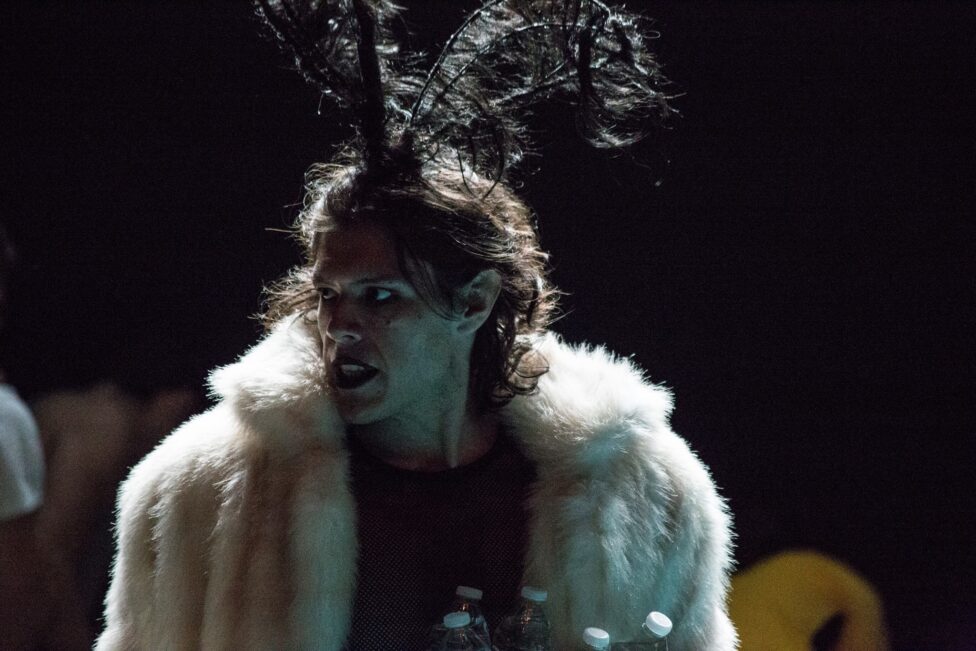
[ID: Cuauhtémoc se para en el escenario con un tocado en forma de polilla, un abrigo de piel blanco y un puñado de botellas de agua de plástico. La iluminación es oscura detrás de él.]
Foto por María José Alos
KQB: Of course, I agree.
CLR: On the other hand I love to listen to you talk about your thoughts as a photographer, listen to your experience in that medium that you started with, ot like talking about your native land, güey, like the theater is for me. I find a series of traditions and knowledge that support me and that I will not invalidate.
KQB: Of course, and there is no reason to not recognize that because both are part of your identity. Both can coexist with each other and can take elements from performance and from theater. I personally don’t have a background in theater, but I consider that some of my explorations in performance are also based on my lived experiences. I really like doing research on musicals like West Side Story that tells a particular view of the history of Puerto Rican migrants living in the US.
And part of the performance I was working on was to try and bring that experience of the theater or the musical theater to performance and that both could be at the same level. And I think that there’s no problem in playing with them, playing with those elements, and mixing them up.
CLR: Of course, all my practice has been developed in the realm of “that is not theater” I have always been there. Two weeks ago, one of my students in the middle of class asked me “But why is that theater?” I love when they ask me this because the answer I give is “it isn’t, I never said it was.” And at the same time I’m not interested in it being so but there is also a place in which I am sure it is.
Also, being in it, in that “in-between”, in that zone that Ileana Diéguez would call liminal seems to have given me the tools to understand that the problem lies in what has been thought to us by white academia, that theater is a form of capitalist production that we owe to Europe and modernity, and that it is called staging. But theater, theater is not that. Theater has never been that, what we understand for theater is a historical accident. It didn’t used to be like that and that means that it won’t always be like that and that is essential. And I think that is precisely why these “in-between” spaces have curiously been inhabited by these types of bodies, by faggots, by people that belong to the trans community, or by lesbians. By these types of bodies that are in the middle, that to me is a very beautiful thing.
KQB: And that is what makes inhabiting the “in-between” interesting hahahaha.
CLR: And that is why residencies of performance are always such a party, no? hahahaha
KQB: Yes, I completely agree with that. When I think of my practice and how the feeling of “in-between” influences it I think first of my experience but also beyond that, the experience that we collectively experience in Puerto Rico. Of that “in-between” in which we live as a Commonwealth, AKA territory, AKA colony, AKA any other term that they would like to make up. But with the passing of time, I have also seen how that “in-between” has been expanding to other parts of my identity. Not only as a political entity, like a queer entity, but also like a person with a disability, and a person in the diaspora. And what it is to be a Puerto Rican in the U.S., going back to what I was saying of West Side Story. The story was really present when I just arrived in New York because people would ask me where I came from? and I would answer “well I’m from Puerto Rico”, then they would proceed to sing to me songs from West Side Story like that one ‘America’: “la la la la la la la América” and I would think … .Oh my God!
Literally that is the reference, the identity that was defined for us. So I have seen little by little how the “in-between” has been expanding to the different identities that I inhabit and also in a technical way of how I explore and play with all the mediums that are now part of my practice. I’m not only concentrating on photography and performance, I have also included video, installation, sculpture and they are always mixed. One way or another they are all part of that being “in-between”, in that space of multiple possibilities.

[ID: A barefoot young brown person wearing a white t-shirt and blue jeans, is intensely pushing a colonial wall in Old San Juan, Puerto Rico.]
Photo courtesy of the artist
CLR: I have a doubt in relation to the “in-between” because I feel like it is not a fixed place but rather a thing that changes its limits and geography every second, like a pendular movement.
And there is a whole specter of internal movement that goes from one side to the other that excites me. Do you feel that inhabiting that space of performance (that is naturally an “in-between” and that you explore it between performance and photography) is what made possible that your work could expand or could incorporate elements of other areas of your life? Or how do you feel that it happens?
KQB: Yes, totally. I think that it begins when one is born, no? Because once we are born, we enter a space of constant categorization and I think that what these different mediums (these artistic practices) have allowed me is to slowly dismantle classifications and those categories that are already internalized in me. And I don’t know if you agree or not, but for me, be it performance or photography or whichever other medium, it’s a process where I create to unlearn. It’s a method of creating to unlearn all those “belief systems” and all those categorizing systems that “have been fed to us” from the moment one is born. So, yes, playing with those mediums has been what has allowed me to expand a bit more on how I move personally in terms of my identities.
CLR: Well, in my case I recognize that I have had both processes. I mean, I feel that from the beginning I landed in performance because I did not fit in any other spaces, like in a stage, I don’t fit in a stage because of the size of my body and its weight. But I also think that performance showed up in my life like the example of that place “in-between” that I was already inhabiting in other dimensions of my life. So in a way it showed up as a medium that was really attractive to me because of my own process of expansion. How do I perform in a gallery, in a museum, in a theater or any other place?
Another path I identify in my practice is the relation with the public space and how it happened as a process of rebellion. Performance opened up a space where I realized everything that I was, what I thought, what I loved, what I wanted etc. and that the thing that did not fit in theater, not only did it fit in performance but it was the primary material. And that is the importance that I recognize about this type of work.
KQB: Yes, I totally agree with that dimension of rebellion. But also with liberation, no? I also remember that I had in mind a type of piece that involved jumping a fence or maybe doing an act that was illegal and how it gave me so much adrenaline. And a process of saying ok, I am creating an image, I am creating an action, I am creating something that will become something else and that people will see and maybe understand the reasons that I’m doing it. So, I don’t know, I agree with you on that element of liberation that performance can bring.
And I think that before working with performance my body just was. I think that while living in Puerto Rico I was so focused on not showing my queerness that I felt like a robot. I was almost like a shell, I felt that my body was a shell inside itself. The only way (now that I think about it and looking back on conversations I had with my mom) I felt like I was holding myself back. Existing that way. But finding a medium that works directly with the body allows you to take actions towards that process of unlearning. That is another type of performance. I also think that it is what drove me to this medium. The process. I felt like little by little that shell started crumbling down and it allowed me to get closer to my genuine identity, how would you say this process was for you?
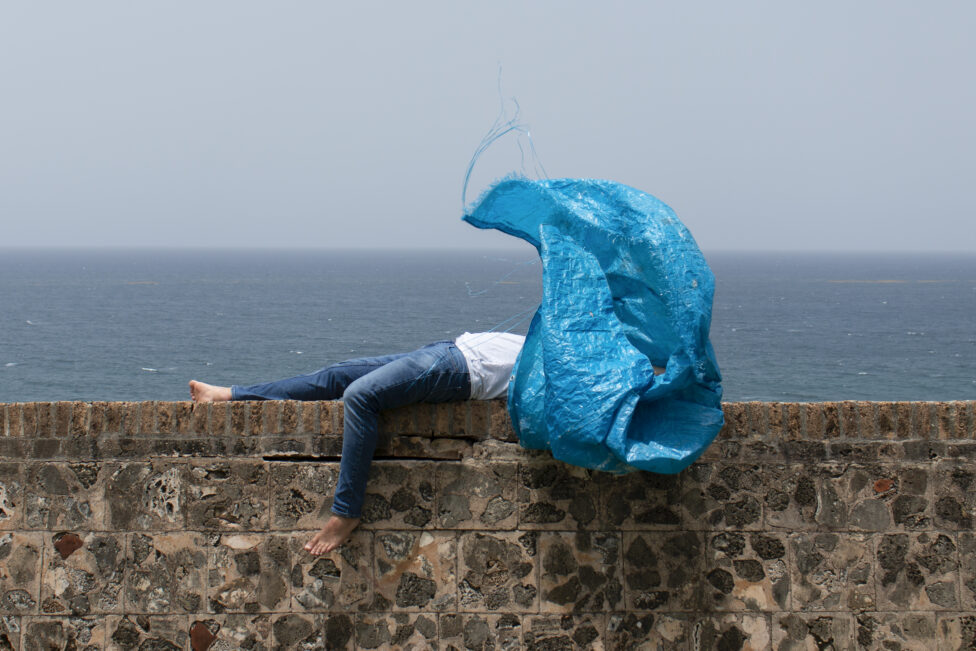
[ID: A barefoot individual with a blue tarp covering their upper body, while laying in a colonial wall of San Juan, Puerto Rico. The tarp is swaying with the wind.]
Photo courtesy of the artist
CLR: I have a doubt in relation to the “in-between” because I feel like it is not a fixed place but rather a thing that changes its limits and geography every second, like a pendular movement.
And there is a whole specter of internal movement that goes from one side to the other that excites me. Do you feel that inhabiting that space of performance (that is naturally an “in-between” and that you explore it between performance and photography) is what made possible that your work could expand or could incorporate elements of other areas of your life? Or how do you feel that it happens?
KQB: Yes, totally. I think that it begins when one is born, no? Because once we are born, we enter a space of constant categorization and I think that what these different mediums (these artistic practices) have allowed me is to slowly dismantle classifications and those categories that are already internalized in me. And I don’t know if you agree or not, but for me, be it performance or photography or whichever other medium, it’s a process where I create to unlearn. It’s a method of creating to unlearn all those “belief systems” and all those categorizing systems that “have been fed to us” from the moment one is born. So, yes, playing with those mediums has been what has allowed me to expand a bit more on how I move personally in terms of my identities.
CLR: Well, in my case I recognize that I have had both processes. I mean, I feel that from the beginning I landed in performance because I did not fit in any other spaces, like in a stage, I don’t fit in a stage because of the size of my body and its weight. But I also think that performance showed up in my life like the example of that place “in-between” that I was already inhabiting in other dimensions of my life. So in a way it showed up as a medium that was really attractive to me because of my own process of expansion. How do I perform in a gallery, in a museum, in a theater or any other place?
Another path I identify in my practice is the relation with the public space and how it happened as a process of rebellion. Performance opened up a space where I realized everything that I was, what I thought, what I loved, what I wanted etc. and that the thing that did not fit in theater, not only did it fit in performance but it was the primary material. And that is the importance that I recognize about this type of work.
KQB: Yes, I totally agree with that dimension of rebellion. But also with liberation, no? I also remember that I had in mind a type of piece that involved jumping a fence or maybe doing an act that was illegal and how it gave me so much adrenaline. And a process of saying ok, I am creating an image, I am creating an action, I am creating something that will become something else and that people will see and maybe understand the reasons that I’m doing it. So, I don’t know, I agree with you on that element of liberation that performance can bring.
And I think that before working with performance my body just was. I think that while living in Puerto Rico I was so focused on not showing my queerness that I felt like a robot. I was almost like a shell, I felt that my body was a shell inside itself. The only way (now that I think about it and looking back on conversations I had with my mom) I felt like I was holding myself back. Existing that way. But finding a medium that works directly with the body allows you to take actions towards that process of unlearning. That is another type of performance. I also think that it is what drove me to this medium. The process. I felt like little by little that shell started crumbling down and it allowed me to get closer to my genuine identity, how would you say this process was for you?
CLR: Well, I have asked myself that question a lot. In fact, it is one of the explorations I would love to be able to do sometime in my life, but I don’t know if this life will give me enough time to be able to explore everything that I would like to investigate. But I know a lot of people, including from what I sense Nicole, that came from the world of dance or theater and whose explorations with interdisciplinary crossings drove them to performance. In some weird way, and I always asked myself why? How did we make that jump? I mean, I understand it theoretically, of course because of the work with the body, but I believe it has to come from somewhere else.
KQB: I think that it is because in all those types of mediums like dance, theater etc. there are rigorous rules and methodologies that you have to follow. Then all of a sudden you bump into performance where the possibilities seem endless and where there seems to be no rules that apply. I mean obviously there is a theory on performance, but it is also a medium where all those structures are not so rigid and it is not so established as it is in theater and dance. Where there are particular schools or specific ways of thinking about dance and theater.
CLR: Yes, and I feel like I started working with the body before I even learned about performance. It wasn’t like I learned about performance and then said this is where I’m from! No, it wasn’t born from that space only. Since I was a child I have been crossing the body in my daily endeavors, overstimulated to a point that sometimes it’s too much, haha
KQB: Yes, the body is the container
CLR: Then finding performance was a place where one could put on the table a way to cope with all of that, to recognize myself as a ball of irritable mass. Like Roland Barthes would say, I only have skin for caressing, but I also feel passionate about thinking that the body is more than just a ball of mass and that there is more to my body than that which is contained inside its skin.
It amazes me, I think for example, even my work with memory has to do with this, that memory requires other bodies, that is not only an episode that happens in our brain but that it crosses the body, individual bodies, and also the social body.
KQB: Yup, the collective body.
CLR: It crosses me, crosses you, crosses Nicole, it has crossed and keeps on crossing and that generates other types of bodies. That to me is amazing.



